Whales have been hunted for thousands of years, and indigenous people still hunt them today from small boats, seeking meat and other products. But deep-sea whaling didn't become a major industry until the 17th century, and the main objective was not meat. It was instead whale oil, extracted from blubber, and baleen, the strainers that many whales use to filter their food out of the ocean.1
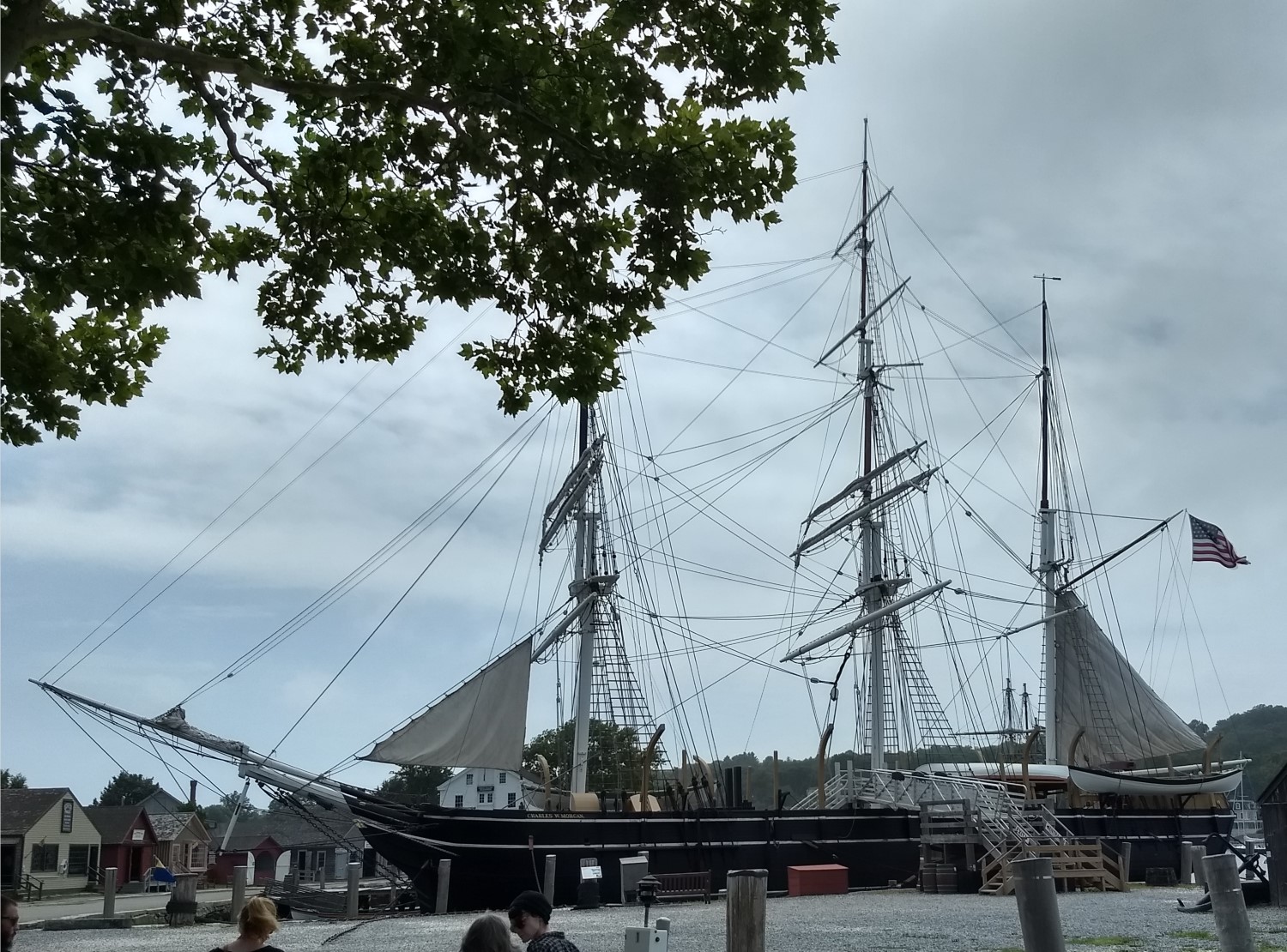
Whaling ship Charles W. Morgan, the oldest merchant ship afloat, at Mystic Seaport
Demand for both products ballooned in the late 18th and early 19th century. Whale oil was the best fuel for new, brighter oil lamps, and also a vital lubricant for the developing industrial revolution, while baleen was used anywhere where a combination of strength and flexibility was required, ranging from buggy whips to corset stays. Whale stocks in the North Atlantic quickly collapsed, and whalers had to venture further and further in search of their prey, often to the remote corners of the Pacific or the Southern Ocean. This trade was initially dominated by Americans from New England, with a high proportion concentrated in Nantucket, Massachusetts.
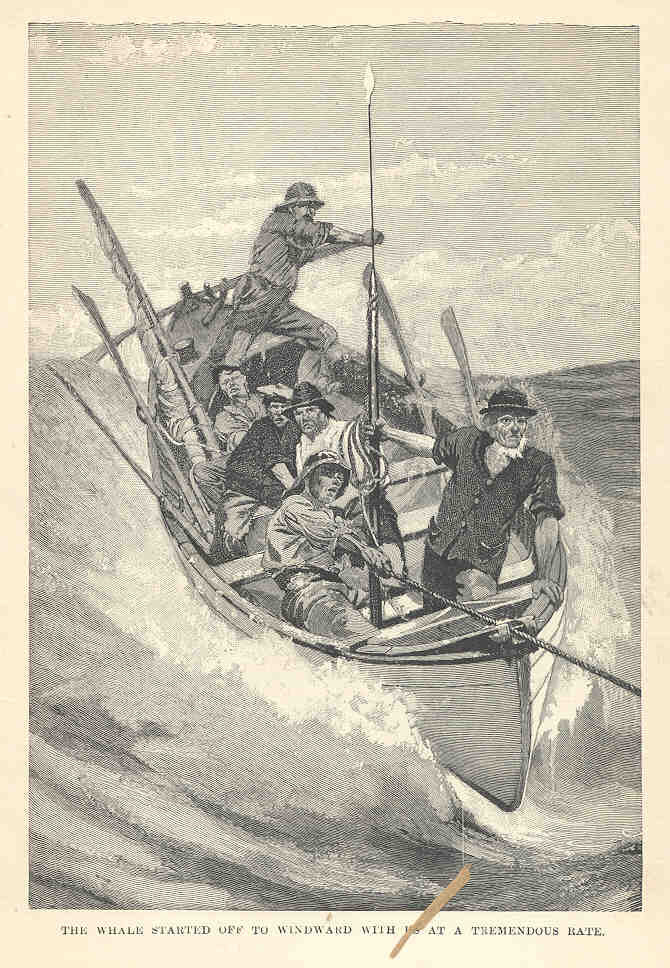
The process of killing and processing a whale was complicated. When the whales were located, boats would be dispatched, and their crews would attempt to plant a harpoon in the whale, with a rope secured from it to the boat. The wounded whale would then flee, dragging the boat with it, a process known as a Nantucket sleighride, which could reach over 20 kts and was just as dangerous as it sounds. When the whale finally tired, the crew would reel it in and kill it. The carcass would be dragged alongside the ship,2 the baleen cut out and the blubber removed, usually in a single long strip. It would then be rendered into whale oil, which was stored in casks that had been transported disassembled. A whaling voyage could take years, and sometimes the crew didn't find anything, a problem for men paid in shares of the voyage's profits. Even more valuable was sperm oil, which was a liquid wax extracted from the heads of sperm whales, where it helps produce sounds and protect them while ramming.3
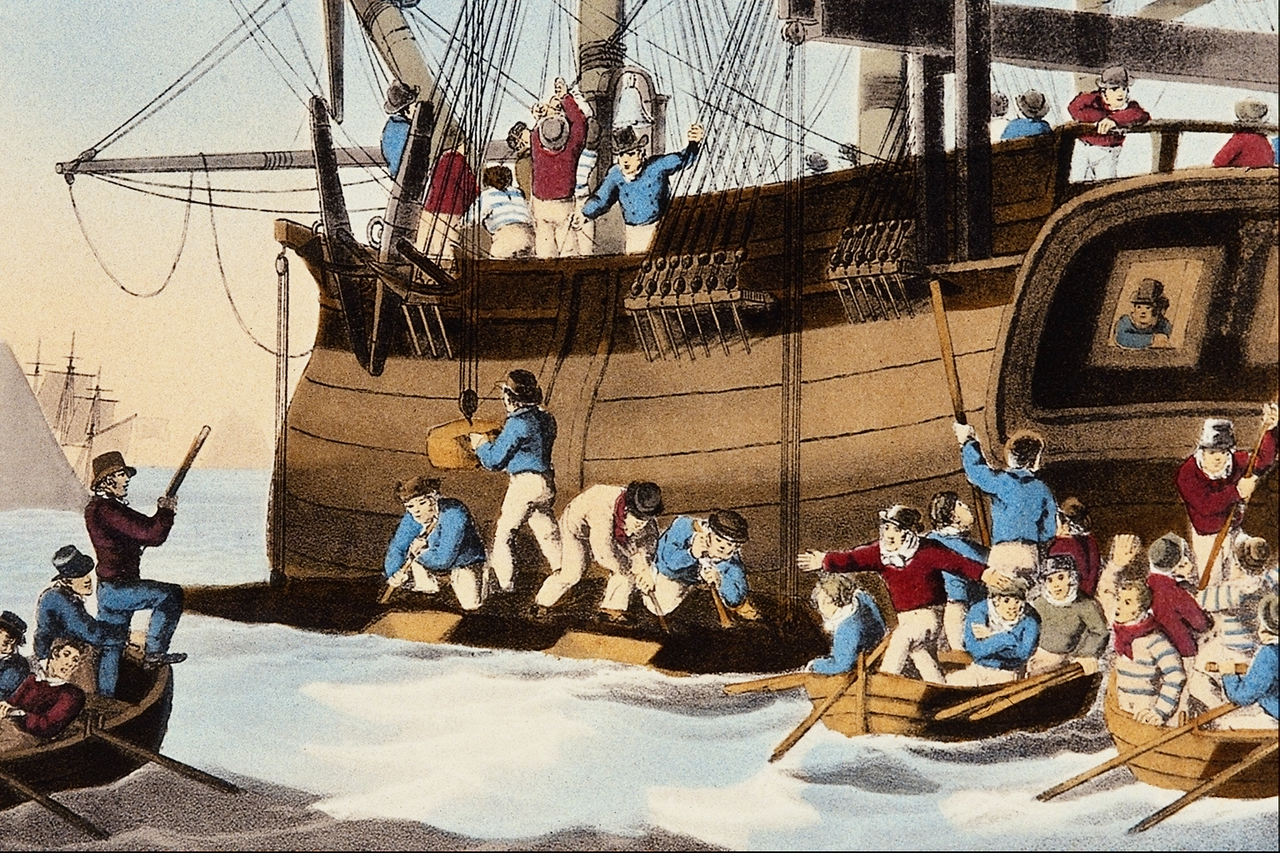
A whale being processed alongside a ship
American participation in the whaling industry began to wane in the 1850s, and the Civil War drove most activity overseas. The development of the petroleum industry saw kerosene take over from whale oil in lighting, although it was still widely used as a lubricant. By the 1870s, explosive harpoons, thrown by guns instead of by hand, were introduced, which killed whales much more effectively, and more whale types could be hunted through the use of pumps to inflate them and keep them afloat. Much of this technology was developed in Norway, whose citizens went on to pioneer much of the rest of industrial whaling. Initially, processing was done at shore stations, such as Grytviken, South Georgia, with the whales being towed ashore. However, the coal-burning catchers of the day couldn't manage more than about 200 miles with a whale in tow, and the factory ship was quickly developed to give more mobility to the process.
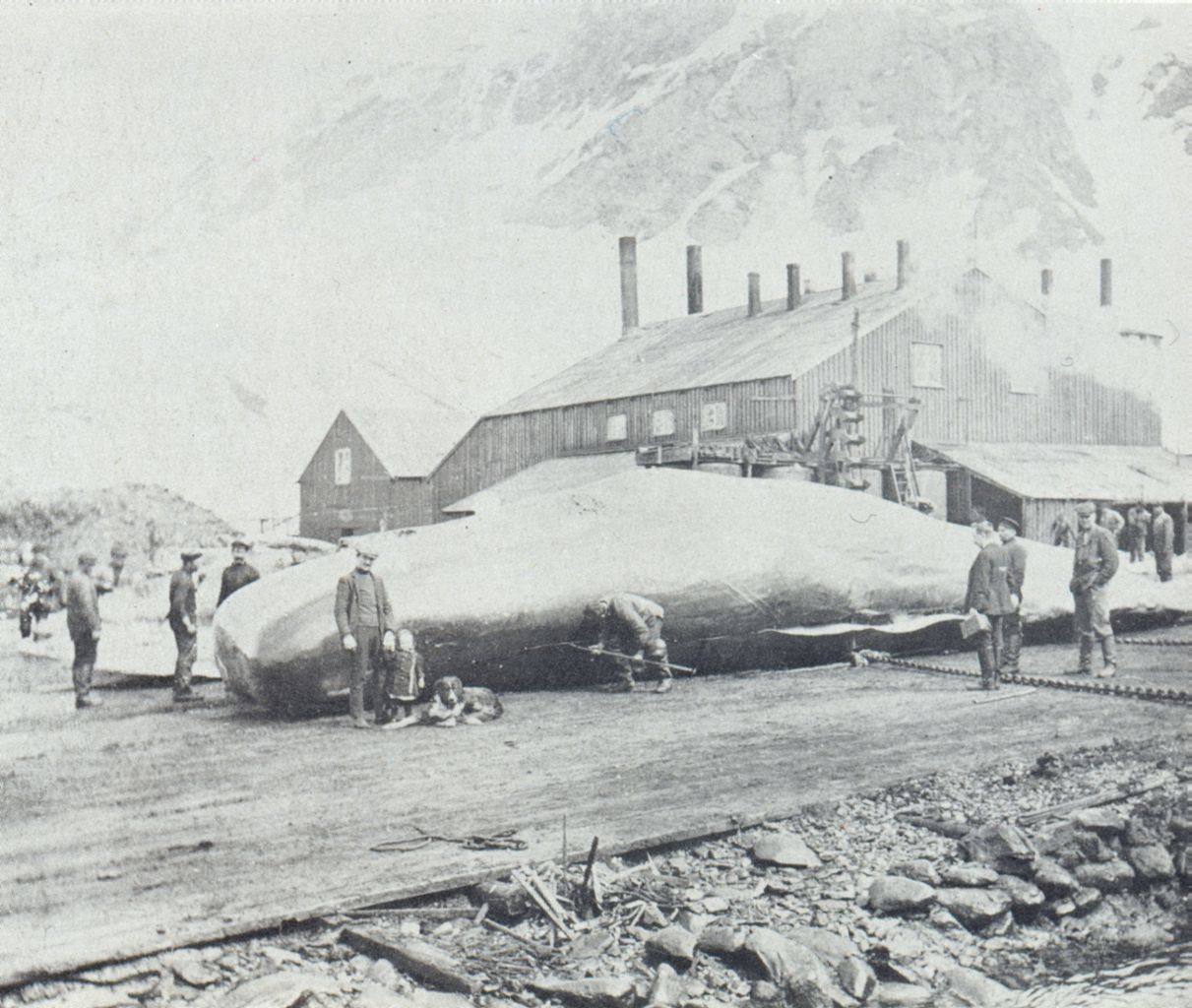
A whale ashore in South Georgia
The early factory ships were cargo ships converted with tanks for whale oil in their holds and cooking facilities belowdecks. Initially, they were used simply as portable whaling stations, anchoring in sheltered waters and getting the freshwater needed for the process from the shore. By 1900, demand for whale oil had begun to decline, but the trend reversed with the invention of hydrogenation in 1906, which allowed the oil to be converted into pure fat, a useful ingredient in many foodstuffs and even explosives manufacture. The scale of whaling that resulted alarmed many, and the British began to license shore-based whaling in their territories in the South Atlantic.
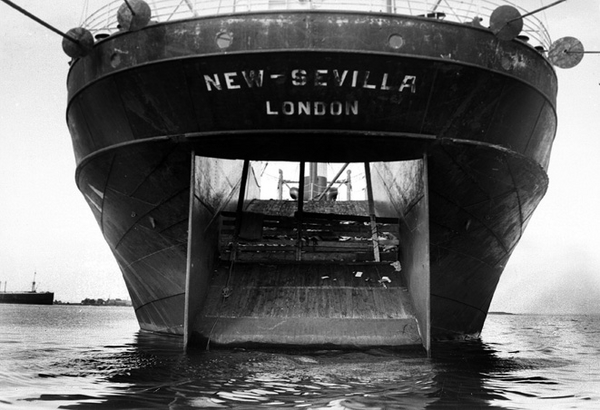
The ramp of factory ship New Sevilla
To evade these restrictions, whalers quickly turned to at-sea processing, building new factory ships that could operate away from land. The biggest problem this raised was the flensing process. Doing it with the carcass afloat was messy and difficult, and tended to leave large amounts of blubber behind, particularly in the rush for whale oil kicked off by WWI. Pack ice sometimes offered a working platform, but something better was needed. Plans to lift carcasses aboard with nets or open a hatch and float it into the ship proved impractical. The answer was the slipway, a ramp, almost always fitted at the stern, which led to the upper deck. When in use, the ship would ballast down to bring the lower edge below the waterline, and the carcass, held by a giant claw, would be winched up. These became common aboard whalers in the mid-20s, and purpose-built factory ships began to replace conversions. These also had facilities for making use of the meat, usually converting it into meal for use in animal feed, although some was canned or refrigerated for human consumption.
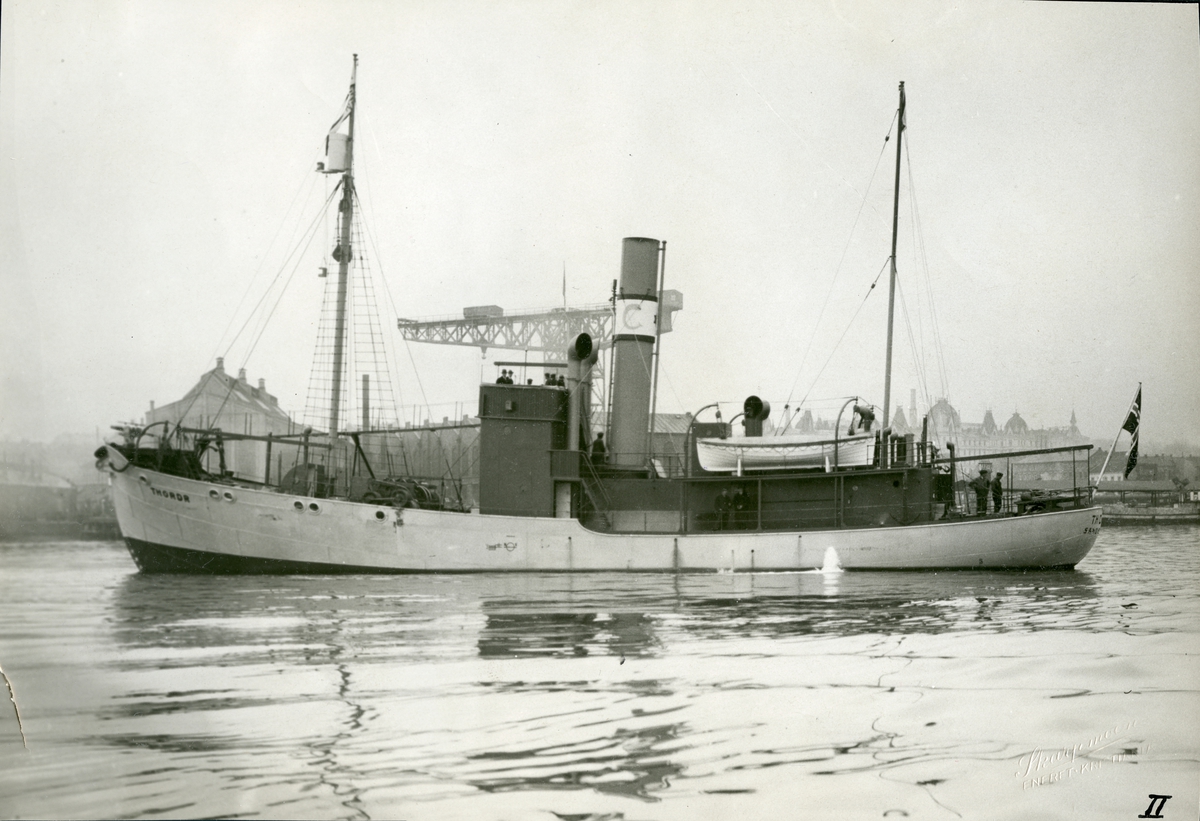
Whale catcher Thordr
The factories couldn't catch the whales themselves, and had to work with dedicated catchers, small vessels equipped with a harpoon gun in the bow and a set of winches to "play" the whale, much as the whalers of old had done.4 Even these much larger vessels were often towed at surprising speeds by the whales they caught, but it was much safer than the Nantucket Sleighride. The other distinctive feature of these vessels was a crow's nest for spotting the ship's prey, a task they were occasionally aided in by seaplanes or helicopters from the factory ship. Seaworthiness was another important characteristic in the harsh seas where whales tended to live, and a whale catcher served as the basis for the Flower class corvettes that guarded Atlantic convoys in WWII.
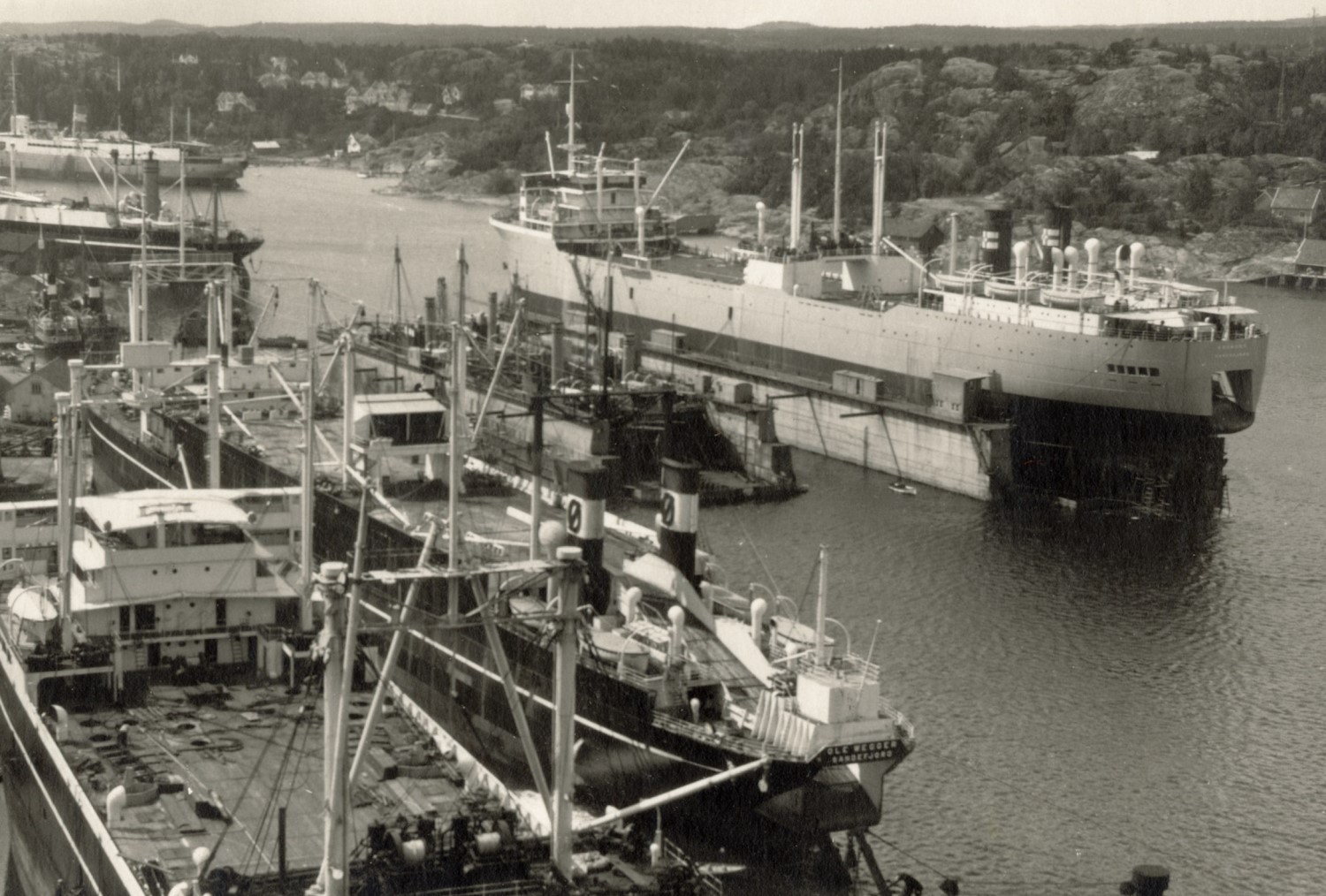
Two factory ships in harbor
By the 1930s, whaling had reached new peaks of success, with margarine being made entirely from whale oil and catches reaching 40,000 whales a year. WWII brought the industry crashing down, as most of the factory ships were converted to other uses, ranging from oil tankers to carriers for vehicles, planes, or even midget submarines. They proved vulnerable to submarine attack, with the entire British and Japanese factory fleets succumbing to torpedoes during the war. Postwar, more factory ships were built, with increasing mechanization and a focus on using the entirety of the whale. Catchers improved, too, with sonar being used not only to track whales but also to herd them.5 Ironically, some wartime escorts were converted for the role, often by unscrupulous operators.
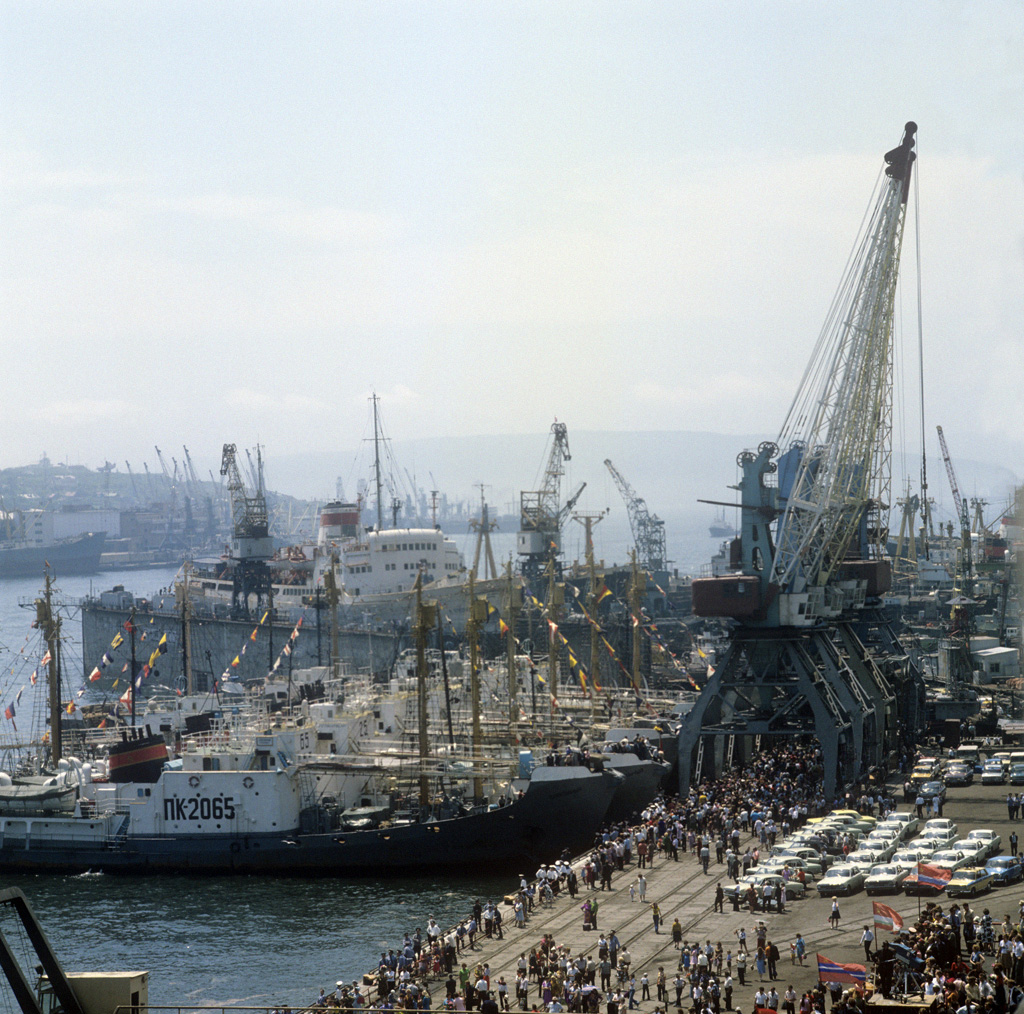
The Soviet whaling fleet
But whaling's days were numbered, as stocks had started to decline precipitously, and the International Whaling Commission was founded in 1946. Initially, its mission was to "provide for the proper conservation of whale stocks and thus make possible the orderly development of the whaling industry", and it wasn't until 2018 that the IWC dedicated itself exclusively to whale conservation. However, the IWC's reach was limited, and whaling in excess of the quotas continued. Private whalers were responsible for some of this, including a fleet owned by Aristotle Onassis, but the biggest culprit was the Soviet Union, whose ships killed over 180,000 unreported whales in what has been described as "the most senseless environmental crime of the 20th century". By the 1960s, whaling was mostly confined to Japan, some of the Nordic nations and the Soviet Union, and opposition to it from environmentalists began to grow.
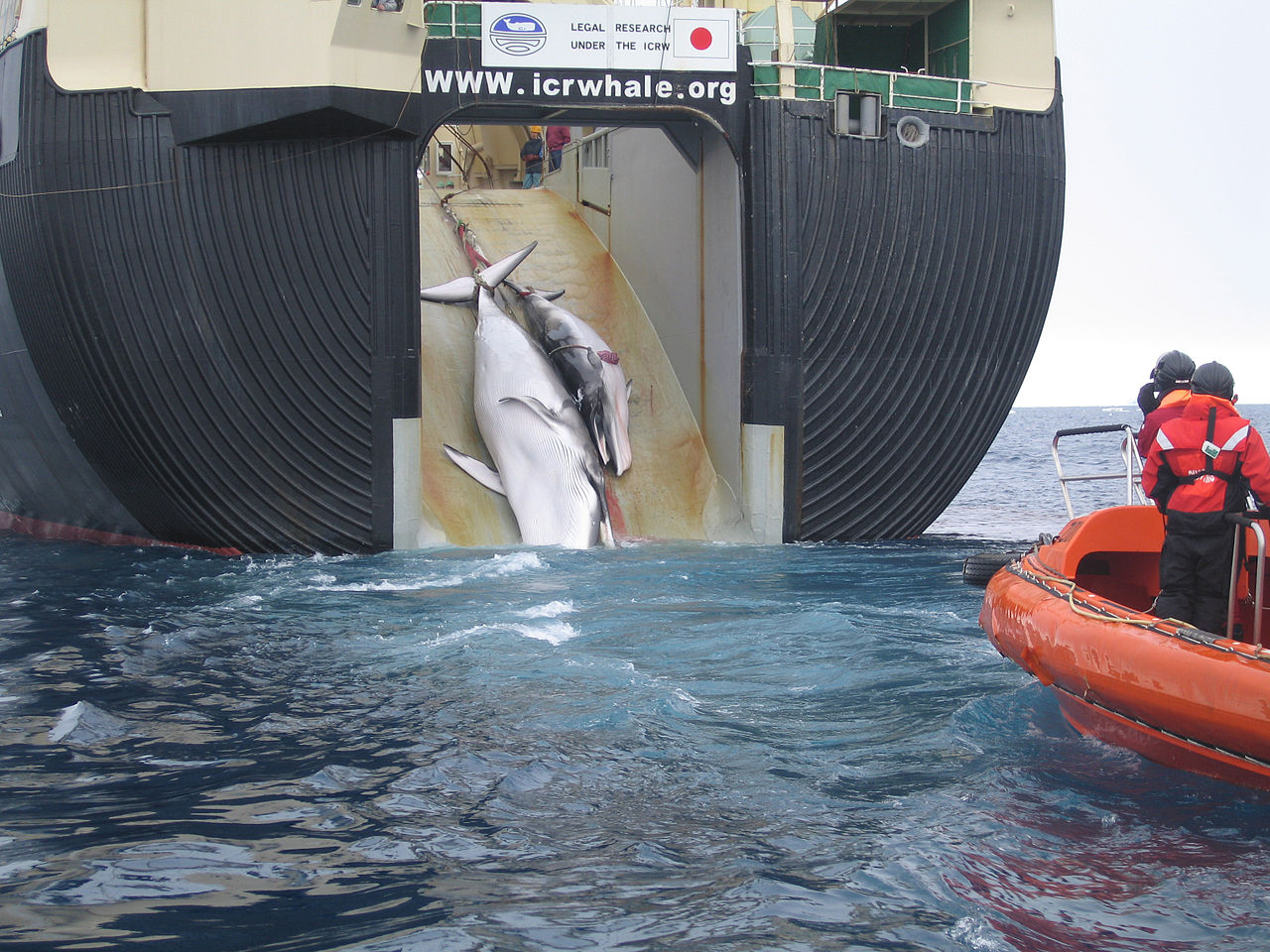
Nisshin Maru, the factory ship of the Japanese whaling fleet, hauls aboard two Minke Whales
In 1982, the IWC imposed a moratorium on commercial whaling, with allowances for subsistence whaling by indigenous peoples who had traditionally hunted whales. Norway objected, and continues to conduct limited commercial whaling to this day, mostly from smaller vessels close to shore, while Iceland has had a rocky relationship with the IWC, but currently hunts under a similar exemption. The IWC charter also allowed governments to issue permits for research whaling, and Japan took advantage of this, although the scientific purposes of the Institute of Cetacean Research were widely questioned. A small amount of scientific data was obtained, although it appeared that the Japanese were most interested in researching the culinary properties of whale meat, and the program has been widely condemned. Starting in 2003, the Sea Shepherd Society began taking direct action against the Japanese. This involved physical interference with their whaling operations, often endangering both vessels.6 Unfortunately, the Japanese appear to have adopted the whaling program as a matter of national pride, and pulled out of the IWC to resume whaling in Japan's EEZ in 2019. A broader resumption of commercial whaling has little support, with only Norway and Iceland in favor, and will probably never occur.
But whales are far from the only denizens of the sea that are pursued by humans. And while fishing has often followed the same environmental course as the whaling industry, it remains legal and a major source of food to this day. We'll take a look at modern oceanic fishing next time.
1 I should emphasize that this post was written entirely on second-hand information, and I have remained in full compliance with Oklahoma law throughout. ⇑
2 This meant that only whales which floated when dead could be hunted. These were the "right" whales, as opposed to wrong whales, which you would want to avoid harpooning because they were dangerous and useless. ⇑
3 This substance, spermaceti, is what gave the whales their names. Initially, it was thought to be the whale's semen. ⇑
4 I am not sure why they weren't using exploding harpoons, which did exist. ⇑
5 This was probably important for the development of modern 3MS. ⇑
6 A reasonable case could be made that this is legally piracy. ⇑

Comments
I feel like there's an interesting explanation for the Foot note Nr 1
Can someone tell me WHY the environmentalists are anti-sea-food, again?
No mention of Moby Dick or the Essex. I am disappoint.
On the reason they didn't use explosive harpoons on whale catchers, I'd guess it was to avoid wastage. Using an explosive harpoon makes a lot of sense if the alternative is paying someone enough to stab a whale in the eye while standing in a row boat getting dragged at 20 knots, but it probably leads to a lot of collateral damage.
That, or legal restrictions on firearms making it harder/less desirable to obtain explosives and keep them on your ship.
@Blackshoe
Oklahoma, for reasons that are not clear to anyone, has a law against whaling. Or at least it's reputed to. I tried to run it down, but couldn't find the relevant law. But the joke was too good to pass up.
@bobbert
No idea.
@cassander
I chose to focus on modern whaling, not older stuff. This series has always been focused on the steam era.
We're doing a little bit of over-fishing (or a lot, either one).
Maybe, it is because I grew up in farm country, but no matter how many times I read bean's line about the IWC's 2018 decision, it just seems mystifying.
Like if you told me, "Last year at their annual meeting, the delegates of the America Cotton Growers Association all committed ritual suicide."
Why would you care if a fishery was well stocked or poorly stocked if you were just going to destroy it anyway.
I had no idea the UK whaling fleet was totally destroyed in the war. They managed to bring in quite a bit of (off-ration) food first, which my dad described as not as good as horse and sort of rubbery. But they weren't exactly picky eaters at the time.
@bobbert
I did a bit of reading on the IWC that didn't make it into the post. The short version is that it was initially intended to promote the whaling industry, but over time a bunch of non-whaling nations joined and saw a chance to burnish their environmental credentials. Also, some of the formerly whaling nations (like the US) switched to being anti-whaling. So by 2018, it was heavily dominated by anti-whaling groups. The only nations besides Japan that were still pushing for a resumption of whaling were Norway and Iceland, and everyone else had switched sides. I'm actually sympathetic to Japan on that particular point, if not in agreement with their methods.
This is a weirdly topical post since everyone on tiktok is currently singing fo'c'sle songs about whaling. https://www.youtube.com/watch?v=u8QpbqDT7tE
Particularly weird given that I finished it a month ago.
Oklahoma law doesn’t actually prohibit whaling per se. The relevant statute (section 295-412) prohibits hunting any animal that is threatened or endangered. Since most whale species fall into one of those categories, Oklahoma does prohibit whaling, but whales are not specifically mentioned in the text of the law. A lot of “weird law” urban legends fall into the pattern of taking a general (and reasonable) law and picking one absurd specific case that is prohibited. Another Oklahoma example is a prohibition on simulated sex acts with bison in a bar. The statute prohibits any real or simulated sex act in a bar, but doesn’t mention bison. So a simulated sex act with a bison is illegal, but only as part of a much more general statute.
Thanks for that. I tried to find that law, which is mentioned a lot of places on the internet, but couldn't. But I also couldn't bring myself to just scrap the joke.
Aside from transgressive gourmands who want to be able to say they've feasted on whale, is there anything industrialized whaling has to offer today that isn't better served by other means? I can certainly see that if you have a bunch of whaling ships in good working order and people trained in the art, you'd want to keep doing it for the time being, but the Japanese at least seem to be building new whaling ships rather than letting the industry die a natural death.
I've actually been to an operating whaling shore station, in Albany, Western Australia. https://en.wikipedia.org/wiki/CheyneBeachWhaling_Station
It is closed now, but at the time I got to see dead whales being dragged onto shore (by winches), cut up (by men with large halberd like things), and huge chunks of blubber being dropped into holes in the ground that lead to the oil rendering plants.
I was only a kid at the time, so what I mostly remember is slabs of whale about the size of suitcases being dragged along the ground to the drop holes, and blood, blood everywhere, everything for hundreds of metres being coated with blood.
@Lambert
Glad somebody brought this up, I've been kind of shocked as to why sea shanties are suddenly filling up my "for you" page. Is there some wider trend I'm missing? Or is just another inexplicable tiktok trend?
@Chuck,
I guess we'll see if tomorrow there is a "surprise" announcement that the latest Disney production is a 3 movie Trilogy of Moby Dick.
Otherwise, I'd put it down to random fluctuations in the cultural brownian motion.
Chuck: It's been a wider trend for a little while now. It sort of makes sense for a group of people adrift and horribly isolated, tbh. https://www.bbc.com/news/uk-scotland-glasgow-west-55661351
@John Schilling
Actually, that's actually the main objective, AFAIK. The Icelandic whaling industry sells a majority of the whale meat to Japan, where it's eaten in quantity. Still, there are reports that say that around 20% of fished whale meat goes unsold. IMHO it's more of a cultural thing than anything with a logic behind it.